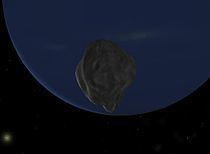Discovered by Voyager Imaging Team Semi-major axis 48 227 ± 1 km Discovered September 1989 Apparent magnitude (V) 23.9 | Discovery date September 1989 Eccentricity 0.0004 ± 0.0003 | |
 | ||
Orbital period 0.2943958 ± 0.0000002 d Discoverers Richard J. Terrile, Voyager Imaging Team Similar Richard J Terrile discoveries, Neptune moons, Other celestial objects | ||
Naiad (/ˈneɪ.əd/ NAY-əd or /ˈnaɪ.əd/ NY-əd; Greek: Ναϊάδ-ες), also known as Neptune III, is the innermost satellite of Neptune, named after the Naiads of Greek legend.
Contents
History
Naiad was discovered sometime before mid-September 1989 from the images taken by the Voyager 2 probe. The last moon to be discovered during the flyby, it was designated S/1989 N 6. The discovery was announced on September 29, 1989, in the IAU Circular No. 4867, but the text only talks of "25 frames taken over 11 days", giving a discovery date of sometime before September 18. The name was given on 16 September 1991.
Physical characteristics
Naiad is irregularly shaped and probably has not been modified by any internal geological processes since its formation. It is likely that it is a rubble pile re-accreted from fragments of Neptune's original satellites, which were smashed up by perturbations from Triton soon after that moon's capture into a very eccentric initial orbit.
Orbital characteristics
Naiad orbits about 23,500 km above Neptune's cloud tops. Since this is below the synchronous orbit radius, its orbit is slowly decaying due to tidal deceleration and it may eventually impact Neptune's atmosphere, or break up into a planetary ring upon passing its Roche limit due to tidal stretching. Naiad orbits Neptune well within its fluid Roche limit, and its density is expected to be low enough that it may be very close to its actual Roche limit already.
Exploration
Since the Voyager 2 flyby, the Neptune system has been extensively studied from ground-based observatories and the Hubble Space Telescope as well. In 2002–03 the Keck telescope observed the system using adaptive optics and detected easily the largest four inner satellites. Thalassa was found with some image processing, but Naiad was not located. Hubble has the ability to detect all the known satellites and possible new satellites even dimmer than those found by Voyager 2. On October 8, 2013 the SETI Institute announced that Naiad had been located in archived Hubble imagery from 2004. The suspicion that the loss of positioning was due to considerable errors in Naiad's ephemeris proved correct as Naiad was ultimately located 80 degrees from its expected position.
